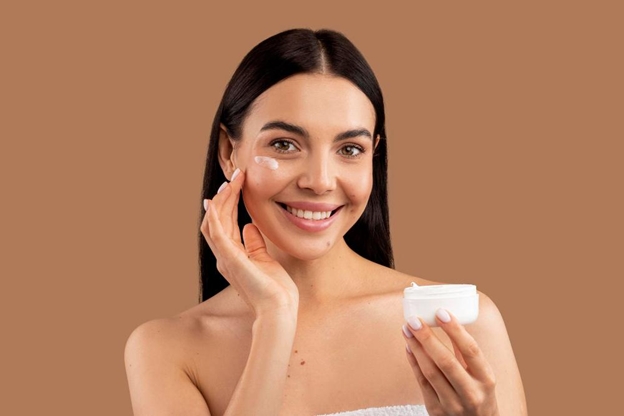- Details

Dry skin can often feel tight, flaky, or uncomfortable, and sometimes no amount of water seems to fix it. That’s where a good moisturiser steps in. It’s not just about adding hydration; it’s about helping your skin hold on to that moisture and repairing the natural barrier that keeps it healthy.
Let’s explore what really makes the moisturiser for dry skin the ultimate choice, and how to use it the right way with the help of sunscreen SPF 50.
Understanding Dry Skin
Common Causes of Dry Skin
Dry skin can be caused by many things, cold weather, long hot showers, harsh cleansers, or even genetics. Low humidity and over-exfoliation can also strip your skin’s natural oils, leaving it rough and sensitive.
When the skin’s protective barrier weakens, it loses water faster than it can be replaced. That’s why simply drinking more water isn’t enough, you need something that locks in hydration.
How Dry Skin Differs from Other Skin Types
Unlike oily or combination skin, dry skin produces less sebum, the natural oil that helps seal in moisture. As a result, it can look dull and feel rough, especially around the cheeks or forehead. The right moisturiser can fill this gap by mimicking what your skin is missing, moisture, nourishment, and protection.
What Makes a Moisturiser the Best Choice for Dry Skin
Deep Hydration and Barrier Repair
The best moisturisers don’t just sit on the surface, they go deeper to replenish hydration and strengthen your skin barrier. When your barrier is healthy, it keeps moisture in and irritants out.
Look for formulas with Ceramides or Hyaluronic Acid, both help attract and retain moisture, while repairing tiny cracks in your skin’s outer layer. Think of them as the “building blocks” that hold everything together.
Long-Lasting Moisture Retention
Dry skin needs more than a quick fix. You want a moisturiser that continues to hydrate throughout the day. That’s where Emollients and Occlusives come in.
Ingredients like Shea butter, Squalane, and Dimethicone create a thin protective layer that slows down water loss. They act like a seal, keeping hydration locked in while softening rough areas.
Skin-Soothing and Healing Benefits
Dry skin often comes with redness or irritation. A soothing moisturiser can calm these flare-ups and restore comfort. Ingredients such as Cica (Centella Asiatica), Aloe Vera, or Panthenol help reduce sensitivity while supporting skin healing.
If your skin feels tight after cleansing, a lightweight but rich moisturiser can instantly ease that discomfort, and with consistent use, help your skin stay calm and supple.
Key Ingredients to Look For in the Best Moisturiser for Dry Skin
Humectants – For Drawing Moisture In
Humectants act like magnets that pull water into your skin. They keep your cells hydrated and plump. Look for Hyaluronic Acid, Glycerin, or Panthenol. These ingredients attract moisture from the air and bind it to your skin, giving it that dewy, healthy look.
Emollients – For Softening and Smoothing
Emollients fill in the small cracks on the surface of dry skin, making it feel smooth and soft. Ingredients such as Ceramides, Squalane, Cica, and Shea Butter are excellent choices. They help restore elasticity while reducing roughness.
Occlusives – For Locking Moisture In
Occlusives are the final shield, they lock everything in place and prevent water from evaporating. Common examples include Petrolatum, Dimethicone, and Beeswax. These ingredients work best at night, allowing your skin to repair itself while you sleep.
A good moisturiser usually blends all three types, humectants, emollients, and occlusives, for complete hydration.
How to Use a Moisturiser Effectively for Dry Skin
Best Time to Apply Moisturiser
Timing is key. Apply moisturiser right after cleansing, while your skin is still slightly damp. This helps trap the existing moisture and boosts hydration. Morning and night applications are a must, especially during colder months when skin tends to dry out faster.
Layering With Serums or Face Oils
If you use serums or oils, layer them wisely. Start with a hydrating serum (like one with Hyaluronic Acid), then seal it with your moisturiser. If your skin feels extra dry, add a drop of face oil on top for that final touch of nourishment.
Common Mistakes to Avoid
- Over-exfoliating: It can strip your barrier, undoing your moisturiser’s benefits.
- Skipping night care: Skin repairs itself best overnight, so never skip your evening routine.
- Using too little product: Apply enough to evenly cover your face and neck, dry skin often needs more than you think.
Conclusion
The best moisturiser for dry skin does more than just hydrate, it repairs, protects, and soothes. It rebuilds your barrier, strengthens your skin’s natural defences, and restores comfort over time.
When choosing one, focus on formulas packed with Humectants, Emollients, and Occlusives, and remember to apply it consistently.
Dry skin may need a little extra care, but with the right moisturiser, it can go from flaky and tight to soft, glowing, and resilient, every single day.
